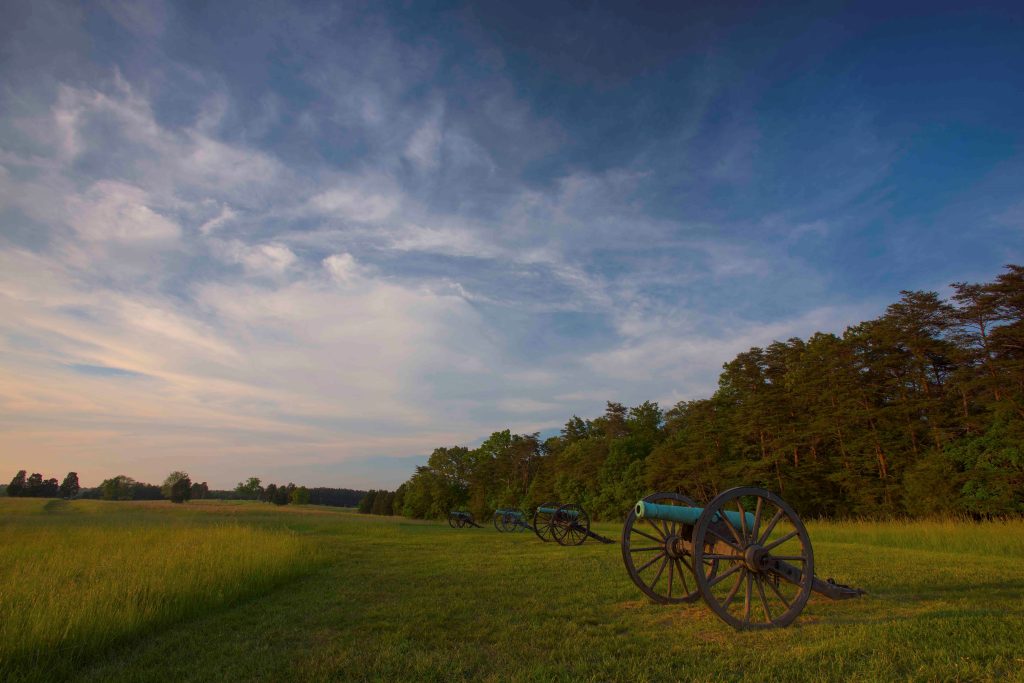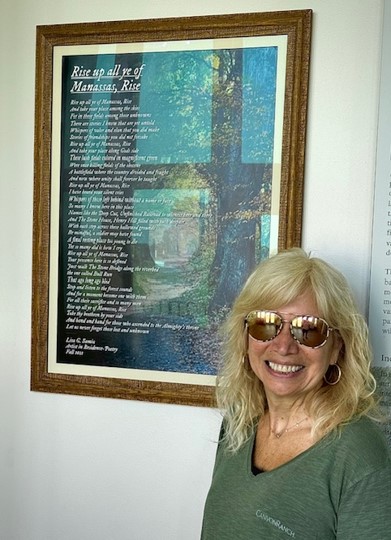My Artist in Residence Experience: Manassas National Battlefield Park Fall 2021 Poetry
ECW welcomes back guest author Lisa Samia.
The Artist in Residence Program sponsored by the National Park Service offers a wide variety of artists the opportunity to live and work on the National Park Service grounds and bring to the community their experiences through their artistic works. These programs offer artists the opportunity to experience living and working in some of our National Park Service’s extraordinary environments. The Artist and Residence Program helped to inspire and cultivate my Nameless and Faceless Civil War poetic works.
The premise of the poetry is that we know that not everyone who witnessed anHenry Hilld experienced the Civil War made it into the history books. So, what of all the unknowns of the Civil War? Who were they? Hundreds of thousands without a name or a face, yet through poetry they are given a chance to share their story, for the first time, for their lost lifetime, that they did not die in vain.
My most vivid memory of my time as an artist in residence was in Manassas, Virginia in fall 2021. Can you imagine living on a National Park battlefield for almost a month? It was truly a dream come true! While the actual historic backdrop of the battlefield was, of course, the impetus for each poem, it was the creation of a lost voice of that battlefield that inspired my work. I walked the trail of the Unfinished Railroad and stood on the spot where Confederate Maj. Gen. Stonewall Jackson’s men threw stones at their Union counterparts for a short time. The stone sentinel of the Stone House today stands silent and strong after being utilized as a hospital during First and Second Manassas. Groveton Cemetery, home to the unknown Confederate dead of the Manassas battles. Matthews Hill, Henry Hill, and Brawner Farm were my backdrop, my backyard, and were always in my sightline.

Each day I walked the various battlefield trails, thinking and immersing myself in the magnificence of the fall season, but also of the silence along the forested trails. The only noise was an occasional animal or bird call, or the intermittent lapping of the water along Bull Run Creek. But the silent perfection and beauty of the battlefield trails were in stark contrast to what happened there during First Manassas (Bull Run) in July 1861 and Second Manassas (Bull Run) in August 1862. I can to this very day remember distinctly where I was on the Bull Run trail when inspiration for my signature poem, Rise up all ye of Manassas, Rise came to me.
I was walking along the Bull Run Creek one October afternoon. The forest was on my right and the creek was on my left. In a moment all the forest sounds suddenly became silent; even the occasional water echoes ceased to flow. I stood for a moment and looked all around, unsure of the sudden silence. A leaf fell at my feet, and as I bent down to pick it up, I rose suddenly and realized that all the unknowns that fought and died perhaps on that very spot where I stood, would no longer have a silent voice. That for both the North and South they could “Rise Up” and have their forgotten and lost voices heard.
So, what of all those unknowns in Manassas? Those whose grave markers there and on our Civil War battlefields rest with only the word unknown to mark their final resting place. What about all of them?
By combining the rhyme and narrative of poetry with Civil War history, a lost voice of the past comes forth to share their experiences and their suffering. A place where the humanity of history and the songs of the soul come together to create a deeper empathy for those lost and unknown.
 The lines of the Civil War North and South are blurred in the poems. There are no border states. No governance or politics, for I believe that “suffering has no boundaries.” These poems go beyond the military aspect of the Civil War, beyond generals, beyond flanking maneuvers, beyond even who won and who lost. The suffering is in the souls of the lost and the forgotten.
The lines of the Civil War North and South are blurred in the poems. There are no border states. No governance or politics, for I believe that “suffering has no boundaries.” These poems go beyond the military aspect of the Civil War, beyond generals, beyond flanking maneuvers, beyond even who won and who lost. The suffering is in the souls of the lost and the forgotten.
The poem Rise up all ye of Manassas, Rise lends itself to the landscape of the battlefield, and events that took place during both Manassas battles. The lines “For in these fields among those unknowns, There are stories I know that are yet untold,” embrace our understanding that so many died unknown, yet still had stories to tell. By giving the unknown a voice, they now have a time and a place to share what they may have seen or experienced during the battles. It is the heart of the poem. And as the poem continues it exalts all those who fought and died there, and serves as a reminder for all of us:
Stop and listen to the forest sounds
And for a moment become one with them
For all their sacrifice and so many men
Rise up all ye of Manassas, Rise
Take thy brethren by your side
And hand and hand for those who ascended to the almighty throne
Let us never forget those lost and unknown
Such was the inspiration for Rise up all ye of Manassas, Rise. This poem was donated as part of my Artist in Residence program to Manassas National Battlefield Park on August 27, 2022. The poem is now hanging in the Visitor Center!
Rise up all ye of Manassas, Rise
Rise up all ye of Manassas, Rise
And take your place among the skies
For in these fields among those unknowns
There are stories I know that are yet untold
Whispers of valor and elan that you did make
Stories of friendships you did not forsake
Rise up all ye of Manassas, Rise
And take your place along God’s side
These lush fields colored in magnificent green
Were once killing fields of the obscene
A battlefield where the country divided and fought
And now where unity shall forever be taught
Rise up all ye of Manassas, Rise
I have heard your silent cries
Whispers of those left behind without a name or face
So many I know here in this place
Names like the Deep Cut, and Unfinished Railroad to witness here and there
And The Stone House, Henry Hill filled with such despair
With each step across this hallowed ground
Be mindful, a soldier may have found
A final resting place too young to die
Yet so many did is how I cry
Rise up all ye of Manassas, Rise
Your presence here is so defined
Just walk The Stone Bridge along the riverbed
the one called Bull Run
That long ago bled
Stop and listen to the forest sounds
And for a moment become one with them
For all their sacrifice and so many men
Rise up all ye of Manassas, Rise
Take thy brethren by your side
And hand and hand for those who ascended to the almighty throne
Let us never forget those lost and unknown
As a concluding thought, no matter how many Civil War battlefields I visit, I carry a part of Manassas with me. Always.
Lisa G. Samia is an Award-Winning Poet & Author who researches, writes, and lectures on American Civil War History. Her latest accomplishments are being selected as the National Parks Arts Foundation’s Artist in Residence for Gettysburg National Battlefield Park 2020 & National Parks Service’s Artist in Residence for Manassas National Battlefield Park 2021, both for her Civil War Poetry.
Notes:
Photo and poem by Lisa G. Samia
Print created by Seharut Suankeow
President | SS&Co. Media, LLC
ssandcomedia.com
https://1drv.ms/i/s!AoBRN8OWSWPchbUqx1uKHH_FRjIDJw?e=Gv0dnb
Poem: Rise up all ye of Manassas, Rise
The Nameless and the Faceless of the Civil War Gettysburg, Manassas & More
Publisher, Destiny Whispers Publishing, LLC May 2023
Of note, Rise up all ye of Manassas, Rise poem is included in The Nameless and the Faceless of the Civil War Gettysburg, Manassas & More, has been nominated by the International Edgar Allan Poe Festival & Awards, Saturday ‘Visiter’ Awards October 4-6, 2024 in Baltimore, MD.
Thanks for posting. This is moving Civil War poetry.
Thank you
Lisa this gives us an appreciation and glimpse of what’s behind your poetry and writings.
Thank you!
So very moving!
Thank you!
Very interesting and such a connection to the past!
Thank you!
Lisa, wonderful prose as usual. Your insight into what could have been is spot on.
Donna
Thank you!